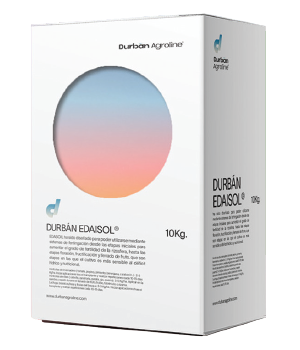DURBÁN EDASOIL PLUS ®

Download
1. Product Description
- 1.1 Product name DURBAN EDASOIL
- 1.2 Product class Humic Acids
- 1.3 Solid Presentation
- 1.4 Toxicological category
- 1.5 Sales formats 10 Kg
2. Guaranteed composition
- Nutrient Concentration (% w/w)
- Humic extract 73.5%
- Humic acids 66.0%
- Fulvic acids 7.50%
- Potassium oxide (K2O) soluble in water 12%
3. Product properties
- a. Solid appearance, in flakes.
- b. pH 9
- c. Humidity 15%
- d. Cation exchange capacity ≈ 300 meq/100 g
4. Recommendations for use: Application by fertigation
- Greenhouse vegetables (tomato, cucumber, pepper, eggplant, zucchini. ) : 2-3 Kg/ha. Start applications after transplanting and perform repetitions every 10-15 days
- Outdoor vegetables (onion, carrot, potato, garlic, leek): 3-5 Kg/ha. Apply at sowing and repeat during fruit, bulb, tuber filling. or rhizome.
- Lettuce, brassicas, strawberries and forest fruits: 2-3 Kg/ha. Start applications after the transplant and perform repetitions every 10-15 days.
- Citrus, Fruit Trees, Vine. Olive grove: 3-5 Kg/ha. First application home activity with spring, with soil temperatures > 17 0C. Repeat during flowering and fruit filling.
- Nursery seedlings: 10 g/foot. Use between 8 and 10 L of broth per seedling.
- Extensive crops (corn, cereal, sunflower, rapeseed, soybeans...): 3-4 Kg/ha. Apply in the planting line. If drip irrigation is available, repeat for grain filling.
5. Application
DURBAN EDASOIL helps to improve physical properties, soil chemistry and biology. Providing the following improvements:
Soil physical properties: - Improves soil structure by creating aggregates. - Confers the ideal porosity that enables adequate breathing of both plants and microorganisms. - Increases the degree of water retention, keeping crops hydrated for longer and satisfying the water needs of the biota to its correct development. - Damping effect of electrical conductivity in the rhizosphere, preventing Mortality of absorbent hairs due to salt stress. - Gives the soil a darker color, favoring warming in the months winter favoring greater root activity. - Soils more resilient to erosion, compaction and sealing processes superficial.
Soil chemical properties: - Increases the degree of availability of nutrients so that they can be assimilated for the crops. - Increases nutrient reserves in the rhizosphere thanks to its high power of cation exchange. - Greater buffering or cushioning power against contaminating elements such as heavy metals or pesticides (through retention in the soil, preventing that are assimilated by the root of the crop).
Biological properties of soil: - Promotes the biological activity of the soil. - Promotes the release of nutrients in the processes of mineralization of organic matter. - Increases the release of CO2, promoting more efficient photosynthesis. - Increases the activity of soil enzymes such as protease or dehydrogenase. - Limits the development of soil pathogens as it reduces the condition anaerobic.
